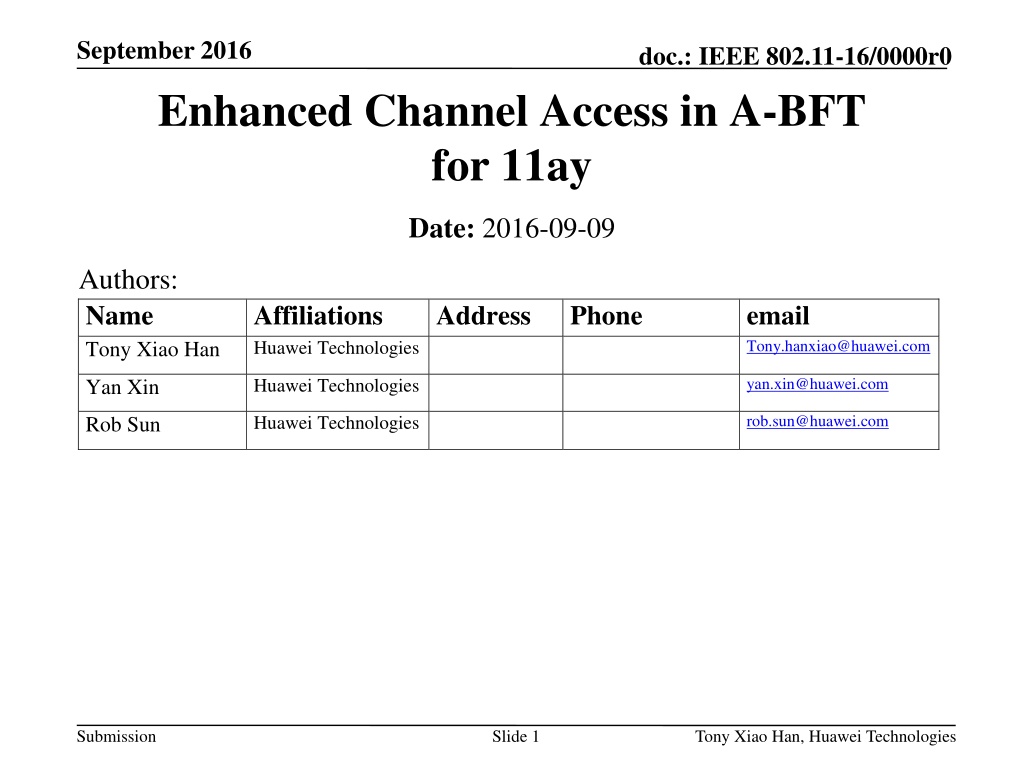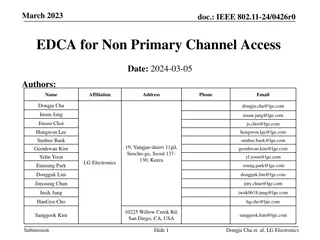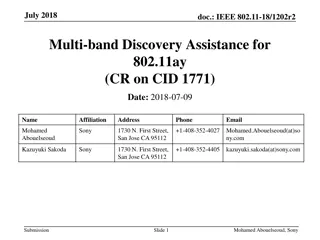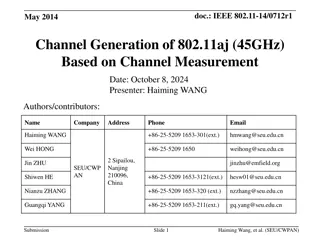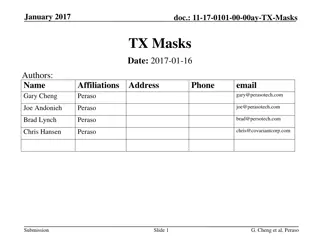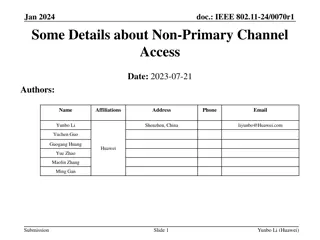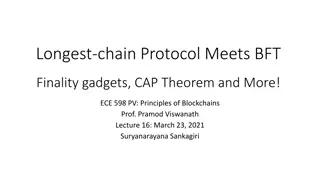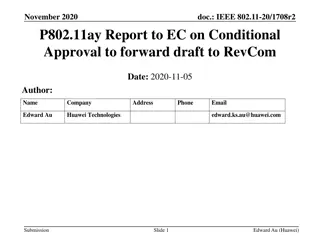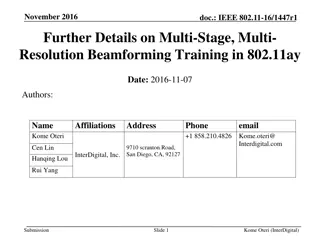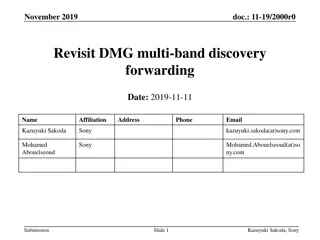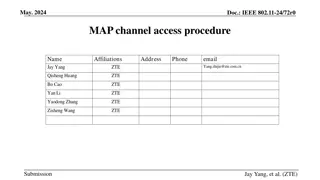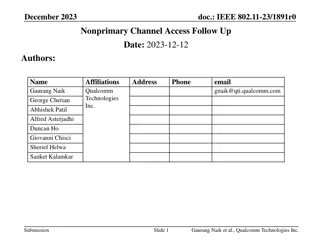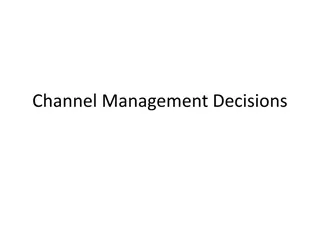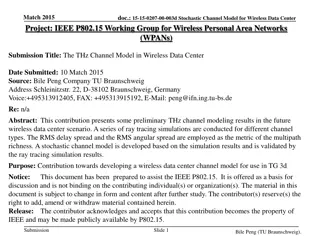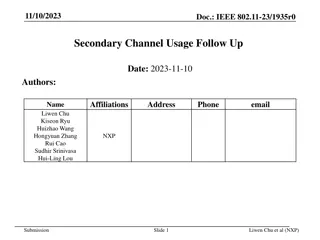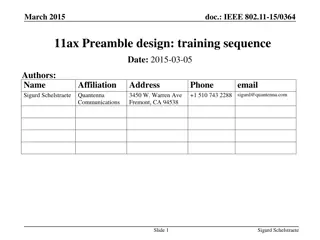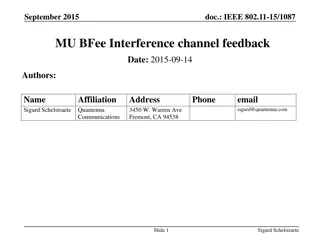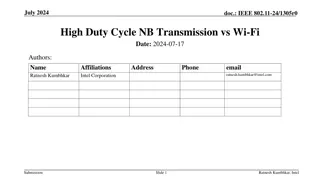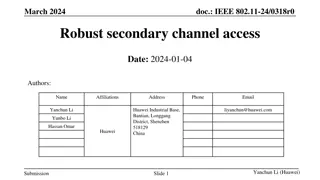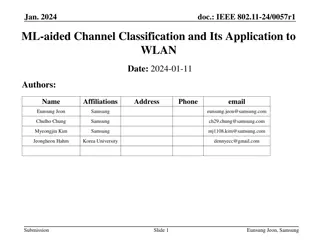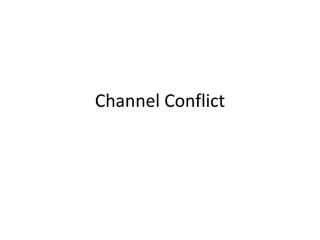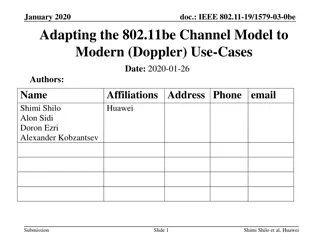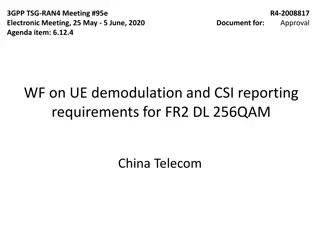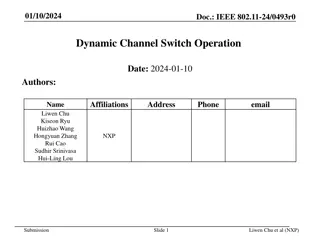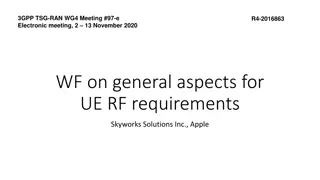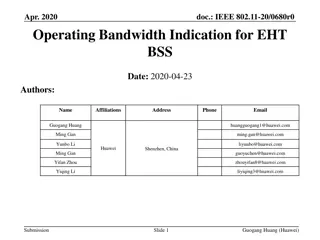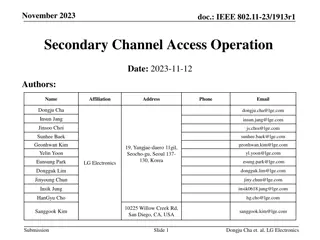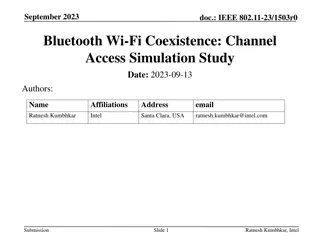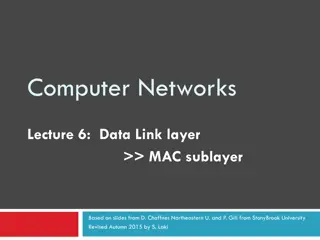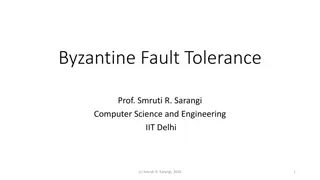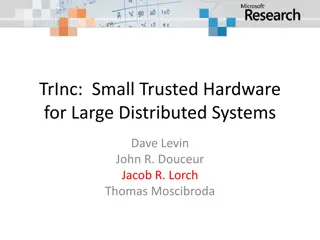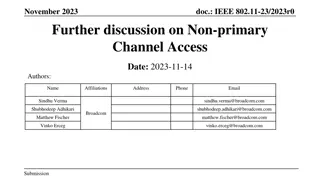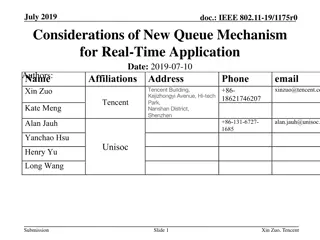Enhanced Channel Access in A-BFT for 11ay
This document discusses the implementation of Enhanced Channel Access in A-BFT for 11ay systems to address collision issues due to limited resources in dense environments. By extending SSW slots, the proposed scheme aims to improve access efficiency in scenarios with a high number of STAs. Different slot contention options are explored to optimize resource utilization and minimize collisions.
Download Presentation

Please find below an Image/Link to download the presentation.
The content on the website is provided AS IS for your information and personal use only. It may not be sold, licensed, or shared on other websites without obtaining consent from the author. Download presentation by click this link. If you encounter any issues during the download, it is possible that the publisher has removed the file from their server.
E N D
Presentation Transcript
September 2016 Enhanced Channel Access in A-BFT for 11ay doc.: IEEE 802.11-16/0000r0 Date: 2016-09-09 Authors: Name Tony Xiao Han Affiliations Huawei Technologies Address Phone email Tony.hanxiao@huawei.com yan.xin@huawei.com Huawei Technologies Yan Xin Huawei Technologies rob.sun@huawei.com Rob Sun Submission Slide 1 Tony Xiao Han, Huawei Technologies
September 2016 doc.: IEEE 802.11-16/0000r0 Outline Background: A-BFT in 802.11ad [1] Motivation Extending the SSW slots in A-BFT Option 1: EDMG STAs only contend in extended SSW slots Option 2: EDMG STAs contend in legacy SSW slots and extended SSW slots Option 3: scalable allocation Conclusion References Submission Slide 2 Tony Xiao Han, Huawei Technologies
September 2016 doc.: IEEE 802.11-16/0000r0 Background: A-BFT in 802.11ad By Beacon Interval Control field in DMG Beacon, the PCP/AP announces the number of SSW slots (the size of A-BFT) in A-BFT Length subfield (3-bit, i.e., at most 8 SSW slots) the number of SSW frames per SSW slot in FSS subfield (4-bit, i.e., at most 16 SSW frames per SSW slot) A STA randomly selects a SSW slot number based on an uniform distribution [0, A-BFT Length-1] to access. Once two or more STAs choose the same slot, collision may happen since they will transmit SSW frames simultaneously. Submission Slide 3 Tony Xiao Han, Huawei Technologies
September 2016 doc.: IEEE 802.11-16/0000r0 Motivation Limited number of available resources (at most only 8 SSW slots) in 11ad A-BFT. Dense and/or outdoor environments is envisioned in 11ay system, which means that the collision will become serious when the number of the STAs increases. Can we solve the collision problem? Submission Slide 4 Tony Xiao Han, Huawei Technologies
September 2016 doc.: IEEE 802.11-16/0000r0 Motivation 1. How could we deal with the collision problem in A-BFT? Extending the SSW slots in A-BFT (providing more resources) seems a nature way to reduce collision. 2. However, the DMG STAs will definitely not recognize the extended SSW slots in A-BFT, but only the legacy SSW slots in A-BFT. How could we deal with this issue? Only the EDMG STAs could contend in the extended SSW slots. And the DMG STA could only contend in the legacy SSW slots If the EDMG STAs could also contend in the legacy SSW slots, then it will be unfair to the DMG STAs (DMG STAs could only contend in the legacy SSW slots, while EDMG STAs could contend in both) With the analysis above, we propose an enhanced A-BFT random access scheme, which simply extends the SSW slots in A-BFT. Submission Slide 5 Tony Xiao Han, Huawei Technologies
September 2016 doc.: IEEE 802.11-16/0000r0 Extending the SSW slots in A-BFT In order to reduce collision, the SSW slots in A-BFT are extended, i.e., providing more SSW slots The DMG STAs only contend in legacy SSW slots Only the EDMG STAs contend in extended SSW slots For the legacy SSW slots, it is already standardized in 802.11ad The number of legacy SSW slots determined by A-BFT Length field (B7 B8 B9) DMG STAs randomly choose Legacy-SSW slots between [0, A-BFT Length-1] DMG STAs will not know there are extended SSW slots, and DMG STAs will start the ATI or DTI according to the exact (absolute) starting time of ATI or DTI, please see the details in Appendix (Q1-3) For the extended SSW slots The number of extended SSW slots is determined through some dedicated bits. EDMG STAs randomly choose SSW slots by following schemes (details in the next slide) Option 1: EDMG STAs only contend in extended SSW slots Option 2: EDMG STAs contend in Legacy-SSW slots and extended SSW slots Option 3: scalable allocation Submission Slide 6 Tony Xiao Han, Huawei Technologies
September 2016 doc.: IEEE 802.11-16/0000r0 Extending the SSW slots in A-BFT EDMG STAs randomly choose SSW slots by following schemes Option 1: EDMG STAs only contend in extended SSW slots EDMG STAs randomly choose extended SSW slots between [A-BFT Length, A-BFT Length + A-BFT Extension-1] where A-BFT Extension can be defined by A-BFT Extension subfield, e.g., (B44 B45 B46 B47), indicating the number of extended SSW slots to be 0-15; A-BFT Extension subfield =(0 0 0 0) indicates that there are no extended SSW slots; Option 2: EDMG STAs contend in Legacy-SSW slots and extended SSW slots EDMG STAs randomly choose legacy SSW slots and extended SSW slots between [0, A-BFT Length + A-BFT Extension-1] where A-BFT Extension can be defined by A-BFT Extension subfield, e.g., (B44 B45 B46 B47), indicating the number of extended SSW slots to be 0-15; A-BFT Extension subfield =(0 0 0 0) indicates that there are no extended SSW slots; Option 3: scalable allocation EDMG STAs randomly choose legacy SSW slots and extended SSW slots between [0, A-BFT Length + A-BFT Extension-1] where A-BFT Extension can be defined by A-BFT Extension subfield, e.g., (B44 B45); A-BFT Extension subfield = (00), (01), (10), and (11) indicates the number of extended SSW slots to be 0, 4, 8, and 16, respectively. (B44 B45) =(00) indicates that there are no extended SSW slots. A-BFT Extension subfield Submission Slide 7 Tony Xiao Han, Huawei Technologies
September 2016 doc.: IEEE 802.11-16/0000r0 Option 1: EDMG STAs only contend in extended SSW slots EDMG STAs randomly choose extended SSW slots between [A-BFT Length, A-BFT Length + A-BFT Extension - 1] where A-BFT Extension can be defined by A-BFT Extension subfield, e.g., (B44 B45 B46 B47), indicating the number of extended SSW slots to be 0-15; A-BFT Extension subfield =(0 0 0 0) indicates that there are no extended SSW slots; An example of Option 1 (at most 15 slots in A-BFT for EDMG STAs): A-BFT Length field (B7 B8 B9) = 011 ( i.e., A-BFT Length-1=3, hence DMG SSW slots=[0, 3] ) A-BFT Extension subfield (B44 B45 B46 B47) = 1000 ( i.e., A-BFT Extension = 8, and A-BFT Length + A-BFT Extension -1= 4+7, hence extended SSW slots for EDMG STAs=[4, 11] ) DMG SSW slots=[0, 3] , EDMG SSW slots =[4, 11] Simply adding more SSW slots for EDMG STAs, then the collision could be reduced when the number of the STAs increases BTI BTI A A- -BFT for DMG STAs BFT for DMG STAs A A- -BFT for EDMG STAs BFT for EDMG STAs ATI ATI DTI DTI Slot Slot 3 3 Slot Slot 4 4 Slot Slot 5 5 Slot Slot 6 6 Slot Slot 7 7 Slot Slot 8 8 Slot Slot 9 9 Slot Slot 10 10 Slot Slot 11 11 Slot Slot 0 0 Slot Slot 1 1 Slot Slot 2 2 Legacy SSW slots for DMG STAs Extended SSW slots for EDMG STAs Submission Slide 8 Tony Xiao Han, Huawei Technologies
September 2016 doc.: IEEE 802.11-16/0000r0 Option 2: EDMG STAs contend in legacy SSW slots and extended SSW slots EDMG STAs randomly choose legacy SSW slots and extended SSW slots between [0, A-BFT Length + A-BFT Extension - 1] where A-BFT Extension can be defined by A-BFT Extension subfield, e.g., (B44 B45 B46 B47), indicating the number of extended SSW slots to be 0-15; A- BFT Extension subfield =(0 0 0 0) indicates that there are no extended SSW slots; An example of Option 2 (at most 8+15 slots in A-BFT for EDMG STAs): A-BFT Length field (B7 B8 B9) = 011 ( i.e., A-BFT Length-1=3, hence DMG SSW slots=[0, 3] ) A-BFT Extension subfield (B44 B45 B46 B47) = 1000 ( i.e., A-BFT Extension = 8, and A-BFT Length + A-BFT Extension -1= 4+7, hence legacy SSW slots and extended SSW slots for EDMG STAs=[0, 11]) DMG SSW slots=[0, 3] , EDMG SSW slots=[0, 11] Even more SSW slots could be allocated for EDMG STAs BTI BTI A A- -BFT BFT ATI ATI DTI DTI Slot Slot 3 3 Slot Slot 4 4 Slot Slot 5 5 Slot Slot 6 6 Slot Slot 7 7 Slot Slot 8 8 Slot Slot 9 9 Slot Slot 10 10 Slot Slot 11 11 Slot Slot 0 0 Slot Slot 1 1 Slot Slot 2 2 Legacy SSW slots for DMG STAs Legacy SSW slots and extended SSW slots for EDMG STAs Submission Slide 9 Tony Xiao Han, Huawei Technologies
September 2016 doc.: IEEE 802.11-16/0000r0 Option 3: scalable allocation EDMG STAs randomly choose legacy SSW slots and extended SSW slots between [0, A-BFT Length + A-BFT Extension-1] where A-BFT Extension can be defined by A-BFT Extension subfield, e.g., (B44 B45); A-BFT Extension subfield = (00), (01), (10), and (11) indicates the number of extended SSW slots to be 0, 4, 8, and 16, respectively. (B44 B45) =(00) indicates that there are no extended SSW slots. An example of Option 3 (scalable allocation with 2 reserve bits for 16 slots): A-BFT Length field (B7 B8 B9) = 011 ( i.e., A-BFT Length-1=3, hence DMG SSW slots=[0, 3] ) A-BFT Extension subfield (B44 B45) = 10 ( i.e., A-BFT Extension = 8, and A-BFT Length + A- BFT Extension -1= 4+7, hence legacy SSW slots and extended SSW slots for EDMG STAs=[0, 11]) DMG SSW slots=[0, 3] , EDMG SSW slots=[0, 11] This scheme requires fewer reserved bits. BTI BTI A A- -BFT BFT ATI ATI DTI DTI Slot Slot 3 3 Slot Slot 4 4 Slot Slot 5 5 Slot Slot 6 6 Slot Slot 7 7 Slot Slot 8 8 Slot Slot 9 9 Slot Slot 10 10 Slot Slot 11 11 Slot Slot 0 0 Slot Slot 1 1 Slot Slot 2 2 Legacy SSW slots for DMG STAs Legacy SSW slots and extended SSW slots for EDMG STAs Submission Slide 10 Tony Xiao Han, Huawei Technologies
September 2016 doc.: IEEE 802.11-16/0000r0 Conclusion Considering the Dense and/or outdoor environments in 11ay system, an enhanced A-BFT random access scheme is proposed. In the proposed scheme, we simply extend the SSW slots in A-BFT, providing more resources. The advantages of the proposed scheme backward compatible with legacy 802.11ad Resources (SSW slots) can be adjusted dynamically for DMG and EDMG STAs Could extend the resources (SSW slots), hence could reduce the collision when the number of the STAs increases Submission Slide 11 Tony Xiao Han, Huawei Technologies
September 2016 doc.: IEEE 802.11-16/0000r0 Straw Poll/Motion 1 Do you agree to add the following text into the SFD: It shall be possible to insert additional SSW slots in the beacon interval for use by EDMG STAs only. Submission Slide 12 Tony Xiao Han, Huawei Technologies
September 2016 doc.: IEEE 802.11-16/0000r0 Straw Poll/Motion 2 Do you agree to add the following text into the SFD: The number of additional SSW slots is indicated by reserve bits in the Beacon Interval Control field. Submission Slide 13 Tony Xiao Han, Huawei Technologies
September 2016 doc.: IEEE 802.11-16/0000r0 References [1] IEEE Std 802.11ad - 2012: Amendment 3: Enhancements for Very High Throughput in the 60 GHz Band. Submission Slide 14 Tony Xiao Han, Huawei Technologies
September 2016 doc.: IEEE 802.11-16/0000r0 Appendix Question 1: If A-BFT is followed by ATI, how will DMG STA know the exact starting time of ATI when using our proposed scheme? Answer: in the Next DMG ATI element of Beacon Interval Control field in DMG Beacon The Start Time field contains the earliest time at which the next ATI in a subsequent beacon interval starts The ATI Duration field contains the duration, in microseconds, of the next ATI in a subsequent beacon interval. Question 2: If A-BFT is followed by DTI, how will DMG STA know the exact starting time of DTI when using our proposed scheme? Answer: in the Allocation field of the Extended Schedule element in DMG Beacon or Announce frame The Allocation Start subfield contains the lower 4 octets of the TSF at the time the SP or CBAP starts The Allocation Block Duration subfield indicates the duration, in microseconds, of a time block for which the SP or CBAP allocation is made Submission Slide 15 Tony Xiao Han, Huawei Technologies
September 2016 doc.: IEEE 802.11-16/0000r0 Appendix Question 3: In special case (i.e., CBAP only field is 1, and the DMG beacon does not include Extended Schedule Element, and a BI including BTI+A-BFT+CBAP only), DMG STAs will not know the starting time of DTI, what will happen? Answer: To deal with this issue, we have the following potential solutions: 1. Mandate the EDMG PCP/AP to always include the optional Extended Schedule element, even CBAP only field is 1 (i.e., BI including BTI+A-BFT+CBAP only). 2. Since the PCP/AP knows all the information and can control the whole system, then the PCP/AP could avoid to use our proposed scheme when the PCP/AP need to set the CBAP only field to 1. Which means that our proposed scheme should not be used in this special case (i.e., CBAP only field is 1, and the DMG beacon does not include Extended Schedule Element, and a BI including BTI+A-BFT+CBAP only) Question 4: Will the PCP/AP know the number of DMG/EDMG STA in the network (to contend for the A-BFT)? Answer: The estimation of the number of DMG/EDMG STAs in the network (to contend for the A- BFT) is an implementation issue and is no different than what already exist in 11ad. And it is out of the scope of the standard and our proposal Submission Slide 16 Tony Xiao Han, Huawei Technologies
September 2016 doc.: IEEE 802.11-16/0000r0 Appendix Question 5: If there is estimation error (estimation of the number of DMG/EDMG STA in the network to contend for the A-BFT), will the proposed scheme still be efficient? Answer: The efficiency of our proposal is obvious, because the main idea of our proposal is to simply adding more SSW slots, even there is some estimation error, the result will be wasting some SSW slots. And one SSW slot will at most be only about 256us ( at most 16 SSW frame in a SSW slot, i.e., (15+1)*16=256us ). However, if the failure in A-BFT will cause the delay for at least one Beacon Interval, which will be hundreds of ms! Hence, comparing to the saved time (hundreds of ms), even there is some estimation error, the wasted time (only hundreds of us) is negligible. Furthermore, in the Dense and/or outdoor environments (which is envisioned in 11ay system), if the number of the station in the network (to contend for the A-BFT) is large (e.g., 15 or even more), then the collision probability will be very large (or even be 100%), which mean the efficiency of the network will very low (or even be 0), and our proposed scheme (providing more SSW slots) will obviously reduce the collision and increase the network efficiency. Question 6: Can you add a mechanism where you can indicate no DMG SSW slots and only EDMG SSW slots? Answer: When the PCP/AP want to allocate no DMG SSW slots and only EDMG SSW slots, the PCP/AP could set the Next A-BFT field to be larger than 0 (which means for DMG STA that there is no A-BFT in this Beacon Interval). And for the EDMG STAs, when they find the Next A-BFT field is larger than 0, then the beginning of EDMG SSW slots is 0, and the number of EDMG SSW slots is determined by our proposed schemes (anyone of the 3 options). Submission Slide 17 Tony Xiao Han, Huawei Technologies
September 2016 doc.: IEEE 802.11-16/0000r0 Appendix Question 7: Is there any estimation algorithm as an example? Answer: Although it is really out of the scope of my proposal, a simple estimation algorithm as an example could be given, based on the paper (Dynamic access class barring for M2M communications in LTE networks): a. Based on the historical information, the PCP/AP could set the initial value of DMG SSW slots and EDMG SSW slots. The historical information may include: e.g., the number of (DMG/EDMG) STAs associated in the network, the number of STAs tried to contend for the A- BFT in the past, the number of success/fail/waste SSW slots in A-BFT based on the SSW slots allocation in the past, etc. b. If the collision in the DMG SSW slots is larger/smaller than the expected number of slots with collision (you can find the calculation in the paper), then adjust the number of DMG SSW slots accordingly (you can find the algorithm in the paper. And it s only one solution, you can design your own algorithm). c. If the collision in the EDMG SSW slots is larger/smaller than the expected number of slots with collision (you can find the calculation in the paper), then adjust the number of EDMG SSW slots accordingly (you can find the algorithm in the paper. And it s only one solution, you can design your own algorithm). Moreover, the estimation algorithm above is kind of an efficient one. But I think we could be more aggressive (e.g., prone to allocate relatively more slots) in this random access system, since this one is different with the others: one SSW slot will at most be only about 256us ( at most 16 SSW frame in a SSW slot, i.e., (15+1)*16=256us ), however, if the failure in A-BFT will cause the delay for at least one Beacon Interval, which will be hundreds of ms! Hence, I think more aggressive estimation algorithm could be further considered Submission Slide 18 Tony Xiao Han, Huawei Technologies
September 2016 doc.: IEEE 802.11-16/0000r0 Appendix Question 8: How to extend to multi-channel? Answer (example): DMG STAs randomly choose SSW slots indicated by A-BFT Length only on primary channel. EDMG STAs randomly choose SSW slots indicated by A-BFT Length & A-BFT Extension on all channels EDMG STAs randomly choose SSW slots between [0, A-BFT Length + A-BFT Extension-1] or [A-BFT Length, A-BFT Length + A-BFT Extension-1] on primary channel. EDMG STAs randomly choose SSW slots between [0, A-BFT Length + A-BFT Extension-1] on secondary channels (e.g.,CH2,CH3,CH4). CH1 slot 0 slot 1 slot 2 slot 3 slot 4 slot 5 slot 6 slot 7 Primary CH2 slot 0 slot 1 slot 2 slot 3 slot 4 slot 5 slot 6 slot 7 CH3 slot 0 slot 1 slot 2 slot 3 slot 4 slot 5 slot 6 slot 7 CH4 slot 0 slot 1 slot 2 slot 3 slot 4 slot 5 slot 6 slot 7 EDMG Slots for EDMG STAs DMG Slots for DMG STAs Submission Slide 19 Tony Xiao Han, Huawei Technologies
